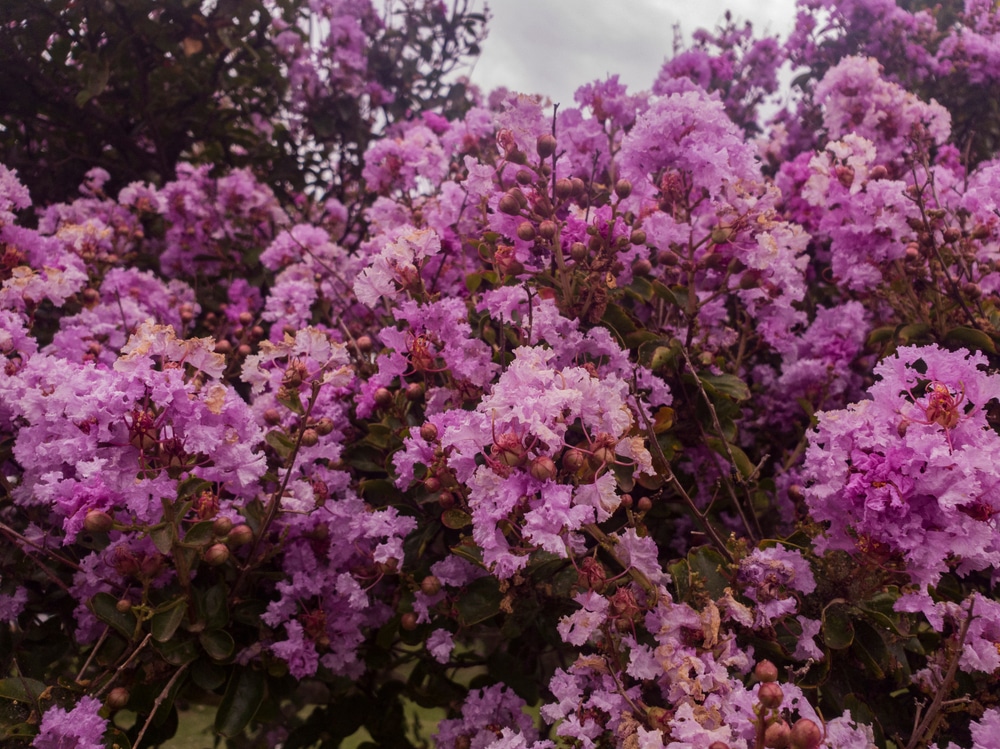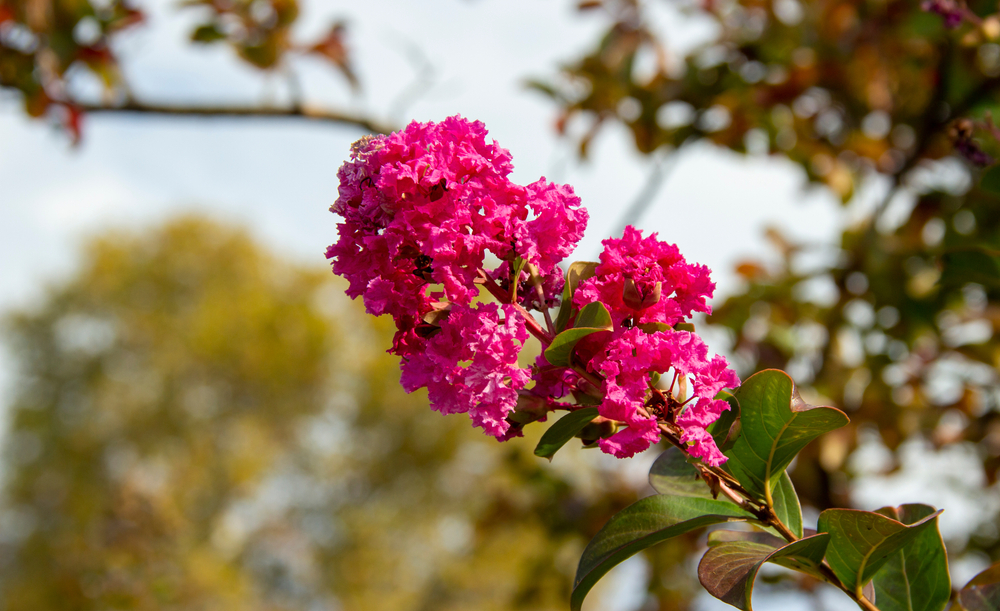One of the most beautiful trees that you can probably see is the Tuscarora Crape Myrtle. This tree is sure to turn heads with its cascading clusters of flowers and glossy green leaves. But what many people don’t realize is that the Tuscarora Crape Myrtle is also a hardy tree that is easy to care for. Here are a few tips to help you keep your Tuscarora Crape Myrtle looking its best.

| Botanical Name | Lagerstroemia Indica ‘Tuscorera’ |
| Common Name | Tuscarora Crape Myrtle |
| Plant Type | Perennial |
| Flower Color | Clusters of pink flowers about 2 inches wide |
| Size When Mature | 240 – 360 inches |
| Bloom Time | Summer |
| Sun Requirements | Full to partial sun |
| USDA Hardiness Zones | 7 – 9 |
| Soil PH Range | 5.0 – 7.0 |
| Soil Type | Example: Acidic, well-draining |
| Water Needs |
Acidic, Neutral, Alkaline, Well-Draining |
| Native Area | Asia |
What You Need to Know About Tuscarora Crape Myrtle
The Tuscarora crape myrtle is a deciduous tree that is native to Asia. It is a Lythraceae family member, including other plants such as pomegranate. The Tuscarora crape myrtle was introduced to the United States in the early 1900s. It has since become a popular landscaping plant.
The tree can grow up to 20-30 feet tall and has bright green leaves that turn red in fall. The leaves are also quite large, measuring up to eight inches long and four inches wide. In addition to their size, the leaves of the Tuscarora crape myrtle are also distinctively serrated. This means that they have small teeth-like projections along the edges of the leaves. This makes its leaves look a bit like saw blades.
The most stunning feature of the Tuscarora crape myrtle is undoubtedly its flowers. A cluster of 30-40 rich pink blooms covers the tree during summer, turning heads and drawing attention. Each individual flower is about 2 inches wide, with six petals that fan out like the rays of the sun.
The petals are slightly ruffled, giving them a delicate appearance. And at the center of each flower is a yellow stamen, which adds a touch of contrast. They are produced in such abundance that they often completely cover the tree, creating a stunning floral display.
The Tuscarora Crape Myrtle is a popular landscaping plant because of its striking appearance and easy-to-care nature. It is relatively drought-tolerant and does not require much pruning or fertilizer.
How to Care for Tuscarora Crape Myrtle
Here’s everything you need to know about growing and caring for a thriving Tuscarora Crape Myrtle:
Light
One of the most important things to keep in mind when caring for a Tuscarora Crape Myrtle is light. The tree prefers full sun, so make sure to plant it in an area that gets plenty of light. The more sun it gets, the more flowers it will produce. During hot seasons, the Tuscarora Crape Myrtle can tolerate partial shade. This will help to protect the leaves from scorching and will also prolong the blooming period.
Water and Soil Needs
Water is the most important element for any plant, and the Tuscarora Crape Myrtle is no exception. Make sure to water deeply and regularly, especially during hot summer days. If the leaves start to wilt or turn brown, that’s a sign that the plant is thirsty.
One thing to keep in mind is that the tree does not like wet feet, so make sure the soil drains well. If you live in an area with a high water table or heavy rainfall, consider planting the tree on a mound to improve drainage.
In terms of soil, The tree thrives in rich, moist, and well-drained soil. It is adaptable to a wide range of soils like chalk, clay, loam, or sand. Having soil with a pH range of 5.0-7.0 will produce the best results. Additionally, the Tuscarora Crape Myrtle is also tolerant of salt, making it a good choice for coastal regions.
Temperature Requirements
In order to thrive, Tuscarora crape myrtles need to be grown in an area that experiences warm weather for most of the year. They are hardy in USDA zones 7-9 but will not tolerate prolonged periods of cold and should be protected from frost.
Fertilizer
The best fertilizer to use on a Tuscarora Crape Myrtle is a slow-releasing balanced fertilizer. Having this type of fertilizer will ensure that the tree will get the needed nutrients released over a period of time, which is ideal for the tree.
Apply the fertilizer in early spring, before new growth begins. For best results, follow the instructions on the package. Overfertilizing can damage the roots and leaves of the tree, so it’s important to be careful.
Common Diseases
The Tuscarora crape myrtle is a hardy plant that can withstand a variety of conditions. Still, it is susceptible to a few common diseases.
Leaf spot is one of the most common diseases that affect the tree. This fungal disease causes dark spots to form on the leaves, which can eventually lead to leaf drops. Powdery mildew is another common disease that can affect the tree. This fungal disease causes a white or grey powder to form on the leaves, stems, and flowers of the plant. It can cause the leaves of the plant to become yellow and distorted. Both of these diseases can be controlled with the use of fungicide.
In addition to diseases, the tree can also be affected by pests. One of the most common pests that affect trees is scale. Scale insects are small, flat, oval-shaped bugs that suck the sap out of plants. Scale insects can cause leaves to turn yellow and drop off the plant. They can also cause the plant to produce fewer flowers. Scale insects can be controlled with the use of an insecticide.
Propagation
One of the best things about Tuscarora Crape Myrtles is that they can be propagated relatively easily. Unlike other plants, which can be finicky about taking root, Tuscaroras will readily grow from cuttings and seeds.
To propagate a Tuscarora Crape Myrtle from cuttings, simply take a six-inch cutting from a healthy branch and plant it in moist soil. You can take cuttings while pruning your Crape Myrtle. Within a few weeks, you should see new growth starting to emerge. Once the plant has established itself, it can be transplanted to its permanent location.
To propagate the tree from seed, simply plant the seeds in a pot or tray filled with soil. Water the seeds regularly, and keep them in a warm place until they germinate. Once the seedlings have emerged, transplant them into individual pots or into your garden bed.
No matter which method you choose, propagation is a great way to get more Tuscarora Crape Myrtles for your garden.

